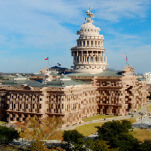The Times Explains That Controversial Front Page Nipple Photo
LatestConsidering the New York Times‘ general hesitancy to publish anything remotely scandalous (curse words, nudity), it made sense that people were surprised they chose to display a woman with a tattoo of the Star of David, a lumpectomy scar and a smidge of her areola. But now the photographer and photo editors involved have spoken and say they actually didn’t think much of it.
The photo accompanies a story called “In Israel, a Push to Screen for Cancer Gene Leaves Many Conflicted” about the high number of women in the country who carry the BRCA1 and BRCA2 genes and the choices they’re making about treatment. Ever since Angelina Jolie’s announcement that she was a carrier for the genes and was getting a preventative double mastectomy, that surgery has apparently gotten much more media attention in Israel, as it has in the U.S. But Israeli photographer Rina Castelnuovo told New York magazine’s Dan Amira there wasn’t as much discussion from those picking the splash image for the article as there was from those viewing it:
“It was an unplanned moment,” she told us in an e-mail. “I was taking the young woman’s portrait and we were chatting about her cancer and the scars.” The inclusion of the areola, she said, was “not intentional.” Castelnuovo noted that the breasts of Ugandan women had been visible in photos in previous installments of the paper’s breast-cancer series, and wondered whether they received a similar reaction.
Castelnuovo says she spoke to the photo’s subject on the phone this morning. Both women agree that the photo “should be seen as what it is, a young woman with cancer. Nothing else.”
The Times‘ public editor Margaret Sullivan spoke to the photo editors involved, and they agreed. “It’s directly on point to the story,” assistant managing editor of photography Michele McNally said. “It conveys a lot of information. It brings the reality to light. It’s also very beautiful – the lighting, the composition, the tone.” But McNally disagreed with Castelnuovo and the anonymous subject of the photo on one part: she told Sullivan she would have preferred it if the woman wasn’t anonymous.
-

-

-

-

-

-

-

-

-

-

-

-

-

-

-

-

-

-

-

-

-

-

-

-

-

-

-

-

-

-

-

-

-

-

-

-

-

-

-

-








































